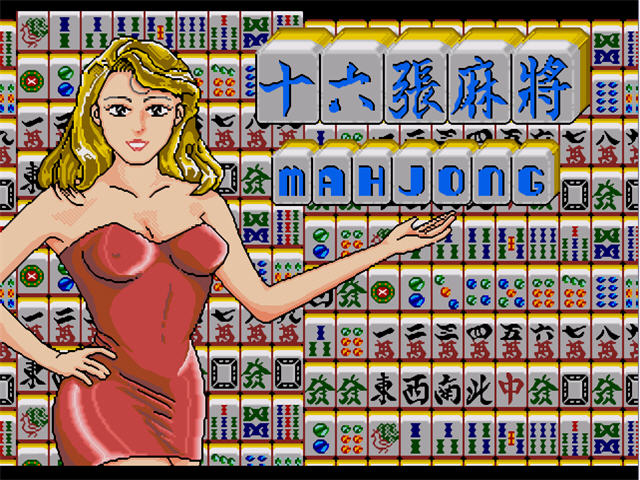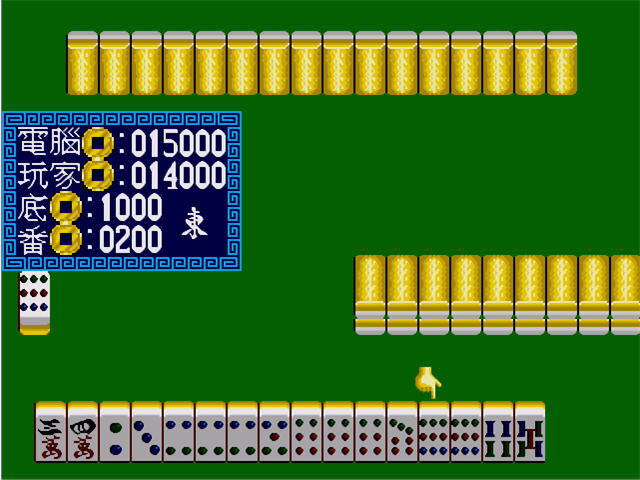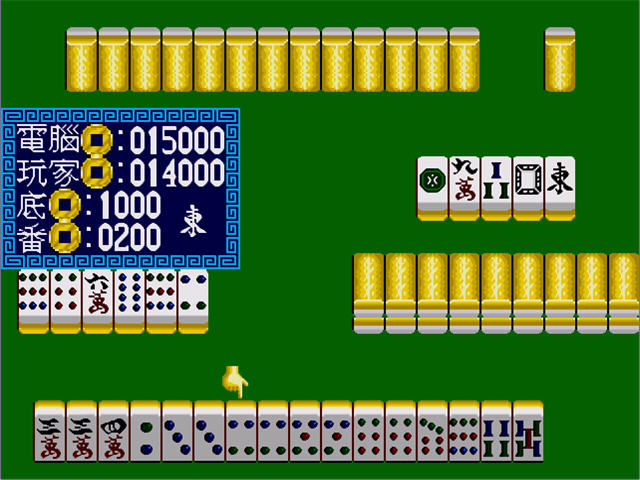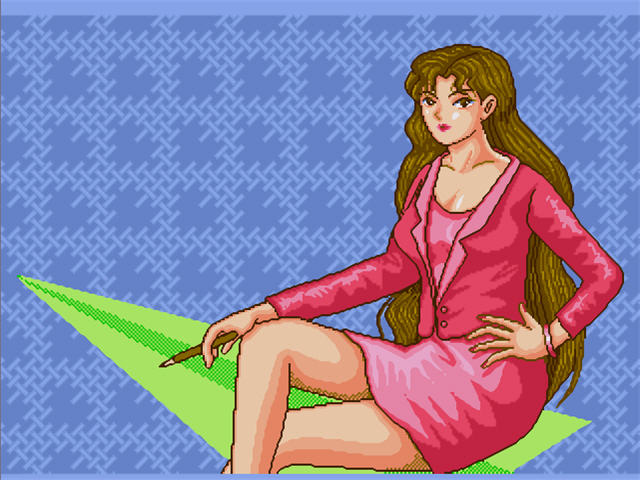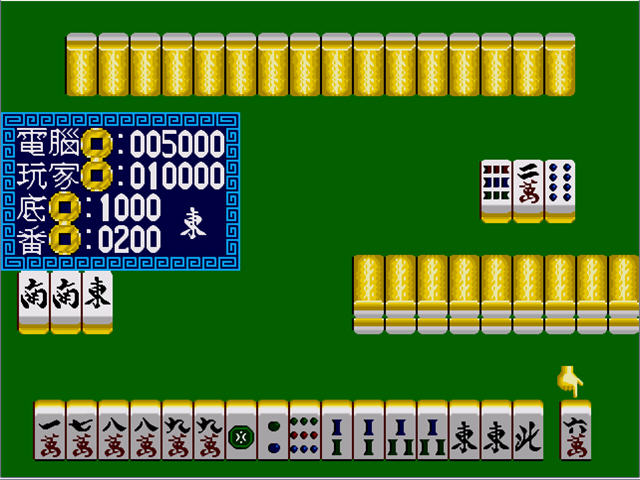16 Tiles Mahjong
Classic 986 Kb Freeware
Mahjong is a Chinese gambling game developed in the mid-1800s. The game is played with a set of 136 or 144 tiles. The basic rules of the traditional game are similar to those of rummy. The players try to make a hand with three- or four-of-a-kind, or runs in the same suit. Hands consist of 13 or 16 tiles.
The Tiles:
Suits The majority of the tiles are divided into three different suits: Dots (Tung), Bamboos (Taio) and Characters (Wan). Each of the three suits run from one to nine with four tiles for each number.
Winds There are also tiles for the Winds. (East, South, West, North). There are four tiles for each Wind.
Dragons There are three Dragons (Red, Green,White). Again there are four tiles for each Dragon.
Flowers and Seasons Mahjong can be played with the addition of eight more tiles; four Seasons and four Flowers. Flowers and Seasons are only used for bonus in the score. They are not part of the hand.
Honors Winds and Dragons are called Honors collectively.
Set up:
The players start the game by rolling dice to designate the winds to each player. The player with the highest roll becomes the East Wind, with South to his right and North to his left. The tiles are then placed facedown on the table and mixed. Each player creates a wall with tiles, 2 tiles high . The walls are placed on the table to form a square.
To create the hands, the current East throws the dice to determine where to break the wall to draw tiles. Each player draws 4 tiles in turn from the wall until each player has 12 tiles and then the East draws two more tiles while other players draw one. If the game is being played with 16 tiles each player takes four tiles at a time until they each have 16 tiles and East picks up one more tile.
Game Play:
Play begins with East discarding a tile. Then moving counter-clockwise, the players take turns drawing a tile from the break, working clockwise on the wall. After a tile has been drawn, one must be discarded in to the middle of the walls face-up. The game continues until someone gets a winning hand. A winning hand consists of four or five sets and a pair. The sets can be of triples ( Pong ) , quadruples ( Kong ), or runs of the same suit ( Chow ). In some variations, there are a number of special hands that can win the game.
The tiles that are discarded may be picked up immediately by another player rather than drawing from the wall. The tile may only be picked up if it completes a set or game for the player. Only the player to the right of the person discarding the tile can use the discarded tile to form a Chow. Pong and Kong take precedence over Chow. The player calls "kong" and picks an extra tile from the opposite end of the wall in order to even out his hand. The set created by picking up the discarded tile is laid down face-up and a tile is discarded. Play then continues to the right. If a player can win with a discarded tile the player calls "mahjong". Mahjong takes precedence over the pong, chow or kong of another player.
After picking a tile, the player can convert a Pong into a Kong by an identical tile from his hand. Other players can rob the tile to complete a hand. The player can also reveal a concealed Kong from his hand; other players can rob one of the tiles of the concealed Kong to complete a hand of 13 Wonders and 13 Wonders only. If there is no one robbing the Kong, the player can then draw a replacement tile from the end of the wall.
When a player draws a season or flower, it is revealed and set along side the player's hand. The player then picks a tile from the opposite end of the wall to replace it and the game continues. The seasons and flowers are used at the end of the game as bonuses.
The Tiles:
Suits The majority of the tiles are divided into three different suits: Dots (Tung), Bamboos (Taio) and Characters (Wan). Each of the three suits run from one to nine with four tiles for each number.
Winds There are also tiles for the Winds. (East, South, West, North). There are four tiles for each Wind.
Dragons There are three Dragons (Red, Green,White). Again there are four tiles for each Dragon.
Flowers and Seasons Mahjong can be played with the addition of eight more tiles; four Seasons and four Flowers. Flowers and Seasons are only used for bonus in the score. They are not part of the hand.
Honors Winds and Dragons are called Honors collectively.
Set up:
The players start the game by rolling dice to designate the winds to each player. The player with the highest roll becomes the East Wind, with South to his right and North to his left. The tiles are then placed facedown on the table and mixed. Each player creates a wall with tiles, 2 tiles high . The walls are placed on the table to form a square.
To create the hands, the current East throws the dice to determine where to break the wall to draw tiles. Each player draws 4 tiles in turn from the wall until each player has 12 tiles and then the East draws two more tiles while other players draw one. If the game is being played with 16 tiles each player takes four tiles at a time until they each have 16 tiles and East picks up one more tile.
Game Play:
Play begins with East discarding a tile. Then moving counter-clockwise, the players take turns drawing a tile from the break, working clockwise on the wall. After a tile has been drawn, one must be discarded in to the middle of the walls face-up. The game continues until someone gets a winning hand. A winning hand consists of four or five sets and a pair. The sets can be of triples ( Pong ) , quadruples ( Kong ), or runs of the same suit ( Chow ). In some variations, there are a number of special hands that can win the game.
The tiles that are discarded may be picked up immediately by another player rather than drawing from the wall. The tile may only be picked up if it completes a set or game for the player. Only the player to the right of the person discarding the tile can use the discarded tile to form a Chow. Pong and Kong take precedence over Chow. The player calls "kong" and picks an extra tile from the opposite end of the wall in order to even out his hand. The set created by picking up the discarded tile is laid down face-up and a tile is discarded. Play then continues to the right. If a player can win with a discarded tile the player calls "mahjong". Mahjong takes precedence over the pong, chow or kong of another player.
After picking a tile, the player can convert a Pong into a Kong by an identical tile from his hand. Other players can rob the tile to complete a hand. The player can also reveal a concealed Kong from his hand; other players can rob one of the tiles of the concealed Kong to complete a hand of 13 Wonders and 13 Wonders only. If there is no one robbing the Kong, the player can then draw a replacement tile from the end of the wall.
When a player draws a season or flower, it is revealed and set along side the player's hand. The player then picks a tile from the opposite end of the wall to replace it and the game continues. The seasons and flowers are used at the end of the game as bonuses.
| About this file | |
|---|---|
| Developer | SEGA |
| Homepage | http://www.demonews.com/page.php?id=8 |
| File Size | 986 Kb |
| Date | |
| Operating Systems | Windows |
| License | Freeware |
| Price | - |
